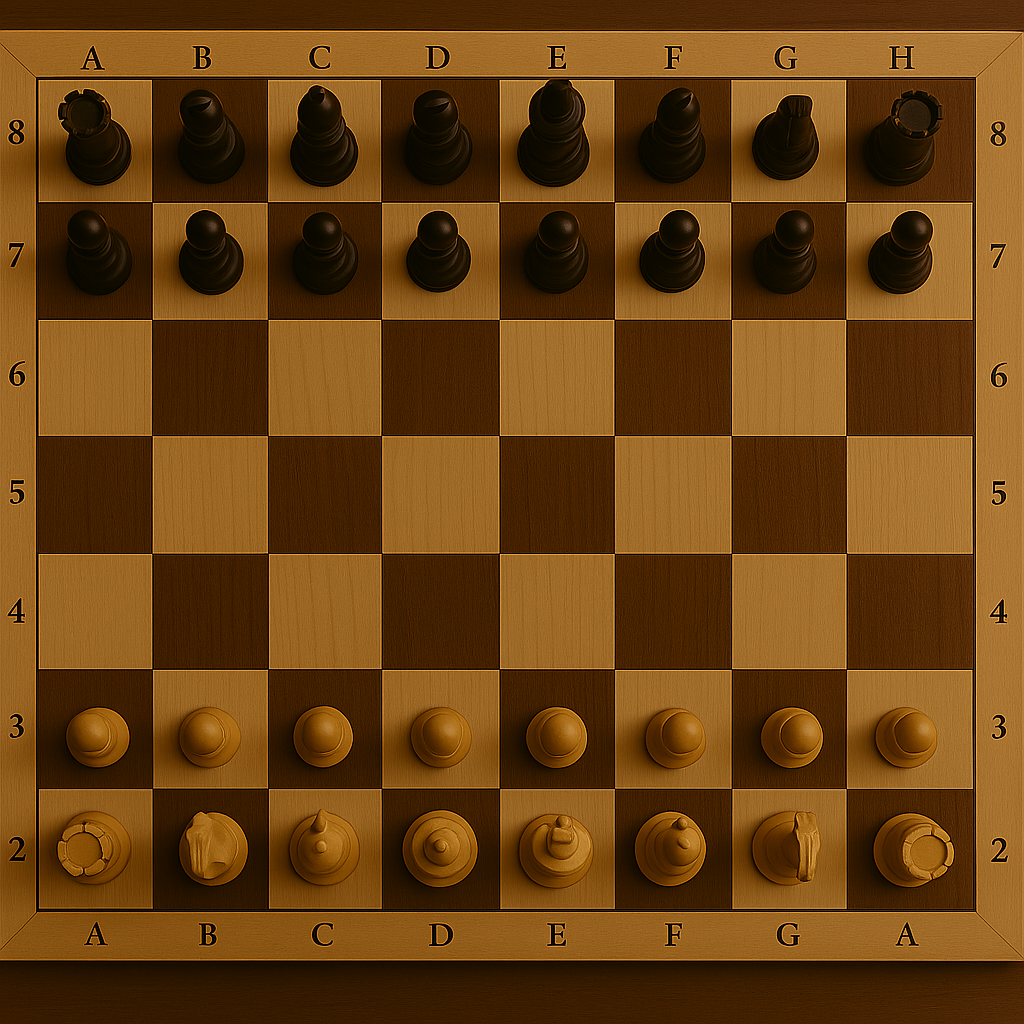Chess is a board game for two players that uses a checkered 8×8 grid. Each player starts with 16 pieces (one king, one queen, two rooks, two bishops, two knights, and eight pawns). The pieces move in distinct ways (for example, rooks move straight, bishops diagonal, knights in L-shapes) and the goal is to checkmate the opponent’s king – that is, trap it so it cannot escape capture. This simple premise belies its depth: games develop into complex battles of strategy and tactics. Chess has a rich history dating back well over a thousand years, and it has spread around the world. Today, it is one of the world’s most popular games, played by millions en.wikipedia.org. Modern online platforms make it easier than ever to play: for example, Chess.com now has over 100 million registered users chess.com. Players of all ages learn the rules, then enjoy using creativity and logic to improve. Whether playing casually in parks, in local clubs, or in top international tournaments, the enjoyment and challenge of Chess are universal.

Chess Rules and Setup
The official rules of Chess are set by FIDE (Fédération Internationale des Échecs, the International Chess Federation) and begin with the setup. The board is placed so each player has a light-colored square on their right corner. Each side then arranges its pieces on the back two ranks: pawns fill the second rank, and the back rank holds the two rooks in the corners, next to knights, then bishops. The queen goes on the remaining square that matches her color (white queen on white, black queen on black) and the king on the other square. In total each player has 16 pieces. FIDE’s handbook explicitly lists these: one king, one queen, two rooks, two bishops, two knights, and eight pawns for White (with the same for Black)fide.com.
How the pieces move is the next basic rule. FIDE rules describe the motions of each piece. For example, “the bishop may move along a diagonal,” and “the rook may move along a rank or file,” while “the queen may move along rank, file or diagonal”. In simple terms, bishops move diagonally any number of squares, rooks move straight any distance, and the queen combines both options. Knights move in an L-shape: two squares in one direction and one square perpendicular; they can also jump over other piecesfide.com. Pawns move differently: each pawn moves forward one square (or two squares on its first move) and captures one square diagonallyfide.com. Pawns have special rules (en passant and promotion) that players learn with experience.
The aim of Chess is checkmate. Wikipedia explains the objective clearly: the “object of the game is to ‘checkmate’ the enemy king (threaten with inescapable capture)en.wikipedia.org.” In practice, players move to attack each other’s king and defend their own. If a king is under threat (in “check”) and no move can remove that threat, the game ends with checkmate and the checking side wins. (Games can also end in a draw in several ways, but checkmate is the definitive victory.) These basic rules – setup, piece moves, and checkmate – give beginners everything they need to start playing. The rest is practice and learning strategy over time.
Chess Tournaments and World Events
Chess is played competitively at all levels. At the very top is the World Championship cycle, which crowns a single World Champion every two or three years. Modern championships are organized by FIDE. For example, FIDE’s official reports note that the 2024 World Chess Championship match (held in Singapore) was historic: it was the first time in 138 years the finalists were both from Asia (China’s Ding Liren vs. India’s Gukesh Dommaraju)worldchampionship.fide.com. Gukesh won that match and became World Champion (his name is now listed by FIDE among the world champions)en.wikipedia.org. The World Championship cycle also includes Candidates tournaments and qualifying events around the world, such as the FIDE World Cup and Grand Prix series. These are held in different countries to give players from all continents a chance to compete and qualify for the title match.
Another major global event is the Chess Olympiad, a biennial team championship where national teams (Open and Women’s) compete. The Olympiad has grown enormously: Chess.com reported that the 2024 Olympiad in Budapest featured 1,893 players across 381 teams – by far the largest everchess.com. (FIDE notes that the 2022 Olympiad had 188 Open teams and 169 Women’s teams, also a record sizefide.com.) Top teams like Russia, USA, China, India and others field the best players. In 2022 Team India won gold medals in both the Open and the Women’s sections, a historic double victoryfide.com. Besides Olympiads, there are many other international tournaments: the annual Grand Chess Tour, tournaments in places like Norway, Paris, St. Louis and Dubai, world Rapid and Blitz championships, online world championships, youth and junior championships, and more. National championships (for example the U.S. Championship or Russian Championship) are also very important locally. In recent years online leagues and events (e.g. on Chess.com or lichess) have further globalized the game. Overall, players around the world have many opportunities to watch, study, and participate in high-level Chess events.
Chess Champions: Past and Present Players
Chess history is studded with famous champions. The very first official World Champion was Wilhelm Steinitz (Austria-USA), who claimed the title in 1886en.wikipedia.org. Later greats include Emanuel Lasker, José Raúl Capablanca, and Alexander Alekhine (early 1900s champions). In the mid-20th century, the Soviet school produced champions like Mikhail Botvinnik, Vasily Smyslov, Mikhail Tal, Tigran Petrosian, and Boris Spassky (champion 1969-72). Anatoly Karpov (USSR/Russia) was World Champion from 1975 until 1985, defending his title twice before losing to Kasparovworldchesshof.org.
In 1972 the Cold War rivalry played out on the chessboard when Bobby Fischer (USA) became World Champion by defeating Boris Spasskyen.wikipedia.org. Fischer’s win made headlines worldwide. The next era was dominated by Garry Kasparov (USSR/Russia). Kasparov became champion in 1985 at age 22, the youngest ever at that timebritannica.com, and he remained champion (in classical chess) through 2000. He is widely considered one of the greatest players ever. Kasparov also famously played world championship matches against IBM’s Deep Blue computerbritannica.com. After Kasparov’s reign, other champions have included Viswanathan Anand (India), who was a five-time World Champion and held the title 2007–2013en.wikipedia.org, and Magnus Carlsen (Norway), who became champion in 2013chess.com and held it for nearly a decade. Carlsen also made history by holding the Rapid and Blitz world titles at the same timechess.com.
Modern Chess features many new stars as well as legends of the women’s game. Judit Polgár (Hungary) is widely regarded as the strongest female player of all time; she competed successfully even in “open” events against top menen.wikipedia.org. Hou Yifan (China) is another famous player – a prodigy who became Women’s World Champion four timesen.wikipedia.org. Among current top players, India’s Gukesh Dommaraju (the 2024 World Championen.wikipedia.org) and China’s Ding Liren (a former champion) are in the spotlight. Other top grandmasters include Fabiano Caruana, Hikaru Nakamura (USA), Ian Nepomniachtchi (Russia), among many. Beginners often study games by champions, and every new generation looks to both historic figures and modern masters to learn strategy and tactics.
Chess for Beginners: Getting Started
Getting started with Chess is easy and fun. Many guides reassure newcomers that learning the rules is straightforward. As notes, “it’s never too late to learn how to play Chess” and learning the rules “is easy”chess.com. A common first step is to practice the initial setup and piece moves: it’s tutorials and apps will walk you through placing the board correctly (each player with a white square on the right corner) and explain how each piece moves. After that, beginners are advised to practice by playing lots of games . Online platforms like Chess.com, offer free lessons, puzzles and game-play so new players can learn interactively. Beginners should try to play at a slow pace at first, taking time to consider moves. Simple tips include always protecting your pieces and trying to control the center of the board.
Joining a community helps a lot: many cities have chess clubs or school programs where experienced players teach novices. National chess federations and local coaches often organize beginner classes or tournaments. Books and videos can help too – for example, basic strategy books introduce opening principles (developing pieces, castling early), tactics (forks, pins, skewers) and endgames (how to checkmate with king and rook, etc.). The key is regular practice: even playing a few friendly games every week will build skills. As Chess.com’s beginner guide suggests, once you know the moves and rules, you should “practice playing lots of games”chess.com. Over time, solving puzzles and reviewing your games will lead to improvement. In short, start small, use the many free resources online (or with friends/teachers), and enjoy the learning process. Chess is a global game, and with each game you play, you join a vast community of enthusiasts learning and growing together.
